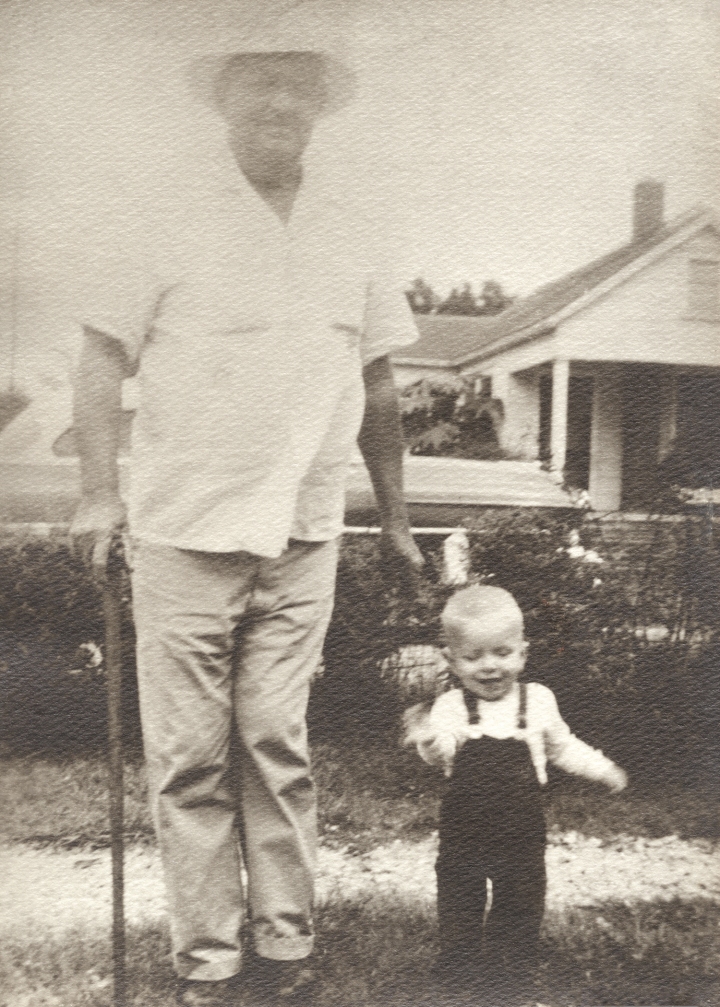The physical record in the lives of ordinary people usually just fades away after a few generations. Thanks to the electronic age, it is possible to chronicle life and the physical histories of families in a much easier manner. My childhood friend, Jay Hughes, is a professor of American Studies at UGA. Having completed his undergraduate degree at Alabama, he must be in quite a quandary in anticipation of the coming College Football National Championship (as far as I am concerned as a Clemson man, anyone who beats Alabama has my admiration). Jay interviewed my Grandmother, Ethel D. Robinson (still with us at almost 92) a few years back on the historians’ technique of photo elicitation. His scholarly article is appended. Photos evoke new and previously uncovered stories of living history in the recesses of the mind of our elders. Photo Elicitation Interview

I recently had the above photo scanned and “cleaned up” digitally. Depicted are my father, Jerry W. Robinson, and his grandfather, F. Sumter Robinson (born 1896) about 1955. This was shortly before Sumter died. With the “cleaned up” photo, I was able to clearly see the cane in Sumter’s hand. This indisputably resolved yet another family mystery. I am fortunate to have inherited this cane from my grandmother a few years back without having any knowledge of its history or provenance, other than the fact that my grandfather used it before he died in 1983. Here’s the cane, held by JER, Jr.. Note that it bears a carved “F” (middle image below). I am 90% sure that this is not Sumter’s doing, but is instead the initial of his grandfather in turn, Eli Franklin “Frank” Robinson (1819-1908), husband of Cicely Kirkpatrick, the impetus for starting this blog. When my father was gifted the subject photo of himself and Sumter some years back, he did not recall the photo being made, but did recall that despite a childhood bout of polio and a resulting withering of his leg, he was an excellent baseball player, at the shortstop position, and proudly served in the US Army Medical Corps in World War I as a horse ambulance driver.
On the themes of physical objects that tie us to our families’ past, I have one last anecdote to tell. Shortly after graduating law school, my mother gifted me the mortal remains of my grandfather John Marice Triplett’s Wittnauer wristwatch (last image below). The watch had not seen the light of day since at least his death in 1981. I had the watch expertly restored and brought to operating condition. Shortly thereafter, I was on a trip to visit relatives in Western North Carolina when our house was burglarized. The thieves took many objects, including this watch. I was heartbroken and assumed I would never see it again. Fast forward three years; when visiting my brother-in-law in Atlanta, GA, we went to the Scott’s Expo antique mart out by Hartsfield International Airport. Among a football field’s area of exhibits, I happened upon a vendor selling only watches. Among the hundreds of watches, I saw what appeared to be a Wittnauer in the exact same model as my grandfather’s. My curiousity piqued, I had the vendor retrieve it. Upon examining it, I knew by Providence that Reese’s watch had returned to me. The telltale was the fact that his watch had a non-matching replacement base metal back that I assume was added at some point by my grandfather or a machinist at DuPont where he worked. The curve of the backing on the edges does not match the contour of the gold case. It was (and is) indeed the same watch, and I am glad to have bought it back. (Coda- after I paid cash for the watch, no questions asked, I had the vendor pull the information he had on it. It was bought in a pawn shop in Savannah. Talk about a one-in-a-million chance of return!)


